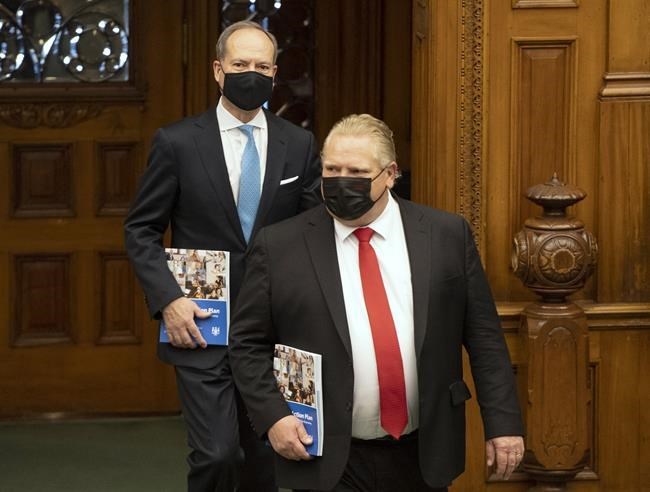TORONTO — Ontario has laid out a $186-billion spending plan the government says will fight COVID-19, help small businesses and support families.
But the promises contained in the budget the Progressive Conservatives unveiled Wednesday come at a steep cost - a $33.1-billion deficit that the province won't be able to eliminate until 2029.
About $6.7 billion will go toward pandemic-related measures, including $1 billion for the vaccine effort and an additional $2.3 billion for testing and contact tracing this year.
Overall health funding is increasing to $69.8 billion, up from $66.7 billion the previous year, with $1.8 billion going to hospitals and $650 million to long-term care to ease pandemic-related pressures.
"Hope is on the horizon," Finance Minister Peter Bethlenfalvy said as he delivered the budget in the legislature.
"Until we reach those shores, we will maintain our relentless focus on protecting people's health and our economy."
But critics said the budget failed to make the urgent investments needed to get through the pandemic, including a lack of funding for paid sick days, paid time off to get vaccinated or plans to hire more education workers.
"This budget doesn't even mention the third wave, let alone help people through it," said NDP Leader Andrea Horwath.
The government defended its plan, saying hospital funding, which was previously announced, will help address COVID-19 expenses and a backlog of surgeries.
The funds for long-term care will be used to prevent the spread of COVID-19 in nursing homes, increase staffing and buy personal protective equipment.
The province also put a price tag on its plan to have nursing home residents receive an average of four hours of direct care every day, which will cost $4.9 billion over the next four years.
That plan was first introduced in the government's November 2020 budget but its cost was not detailed. The government said the funds will help recruit 27,000 personal support workers to help achieve the new standard.
The budget also contains funds to help hard-hit small businesses and families address pandemic-related costs.
The government said it will offer a second round of grants to small businesses and create a new job training tax credit. The grant program, first introduced in January, provides between $10,000 to $20,000 to help small businesses affected by provincial lockdowns.
The government estimates the program will cost $3.4 billion and help an estimated 120,000 small businesses.
The budget also introduces a new Ontario Jobs Training Tax Credit to help retrain people who have lost their jobs during the pandemic.
The program – which will cost $260 million – will provide up to $2,000 per person to pay for half of their eligible training expenses.
Families with children can expect a third round of payments through the Ontario COVID-19 Child Benefit, with the amount doubling to $400 per child - $500 for children with special needs.
Ontario will also spend an additional $2.8 billion to bring broadband access to more people across the province by 2025. The funding will help expand broadband service to 700,000 additional homes, the budget indicated.
A spokesman for the Canadian Federation of Independent Business said the group applauded the government's move to double grant funding for small businesses, but asked for some amendments.
"Thousands of hard-hit small businesses across the province remain ineligible," said Ryan Mallough. "CFIB urges the Ontario government to expand eligibility for this important program."
Green party Leader Mike Schreiner said the budget fails to address a number of issues including further measures to address a third wave of COVID-19, climate change and the need for more affordable housing.
"It feels like the finance minister left a few chapters of this budget at the printers," he said.
The CEO of the Registered Nurses' Association of Ontario said she was disappointed by the budget. While it spends on hospital funding and mental health services, it doesn't set aside money to staff many health-care settings.
"Nurses are saying that they have been poorly supported by this government during the pandemic," Doris Grinspun said. "This budget does nothing to tell nurses 'Hold on, please don't leave.'"
The budget charts a long path to balance, with the books not expected to enter the black until a hypothetical third term under the Progressive Conservatives.
The document projects Ontario will run a deficit of $26.2 billion next year and $18.7 billion in 2023-24, with the shortfalls ending in 2029-30 with a $900-million surplus.
When asked about the years of deficits that lie ahead, Bethlenfalvy said he had no regrets over the government's pandemic spending.
"I’d do it over again, protecting the health and well-being of the people of Ontario," he said. "This is what responsible governments do."
This fiscal year, the government's balance sheet will be helped by a rebound in revenues as the economy is projected to gain strength, the budget indicates.
Total tax revenue is expected to rise to $104.8 billion, up from $99.1 billion in 2020-21.
The government is also projecting additional revenues from some of its business enterprises, like the Ontario Cannabis Store and the Ontario Lottery and Gaming Corporation.
The province said it's projecting cannabis revenues to jump from $70 million last year, to $170 million in 2021-22.
Government revenues from OLG dropped to $300 million last year – attributed to factors including the closure of many casinos – but are projected to increase to $1.2 billion this year. That is still down by over $1 billion from revenues received in 2019-20.
This report by The Canadian Press was first published March 24, 2021.
Shawn Jeffords and Holly McKenzie-Sutter, The Canadian Press



